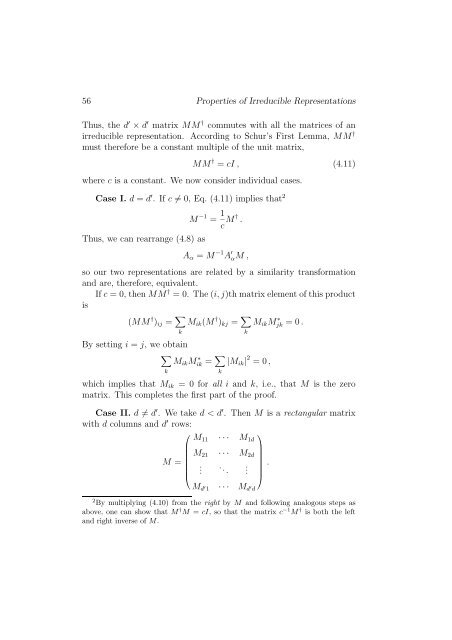Chapter 4 Properties of Irreducible Representations
Chapter 4 Properties of Irreducible Representations
Chapter 4 Properties of Irreducible Representations
Create successful ePaper yourself
Turn your PDF publications into a flip-book with our unique Google optimized e-Paper software.
56 <strong>Properties</strong> <strong>of</strong> <strong>Irreducible</strong> <strong>Representations</strong><br />
Thus, the d ′ × d ′ matrix MM † commutes with all the matrices <strong>of</strong> an<br />
irreducible representation. According to Schur’s First Lemma, MM †<br />
must therefore be a constant multiple <strong>of</strong> the unit matrix,<br />
MM † = cI , (4.11)<br />
where c is a constant. We now consider individual cases.<br />
Case I. d = d ′ .Ifc ≠ 0, Eq. (4.11) implies that 2<br />
Thus, we can rearrange (4.8) as<br />
M −1 = 1 c M † .<br />
A α = M −1 A ′ αM,<br />
so our two representations are related by a similarity transformation<br />
and are, therefore, equivalent.<br />
If c = 0, then MM † = 0. The (i, j)th matrix element <strong>of</strong> this product<br />
is<br />
(MM † ) ij = ∑ k<br />
M ik (M † ) kj = ∑ k<br />
M ik M ∗ jk =0.<br />
By setting i = j, we obtain<br />
∑<br />
M ik Mik ∗ = ∑ |M ik | 2 =0,<br />
k<br />
k<br />
which implies that M ik = 0 for all i and k, i.e., that M is the zero<br />
matrix. This completes the first part <strong>of</strong> the pro<strong>of</strong>.<br />
Case II. d ≠ d ′ . We take d













